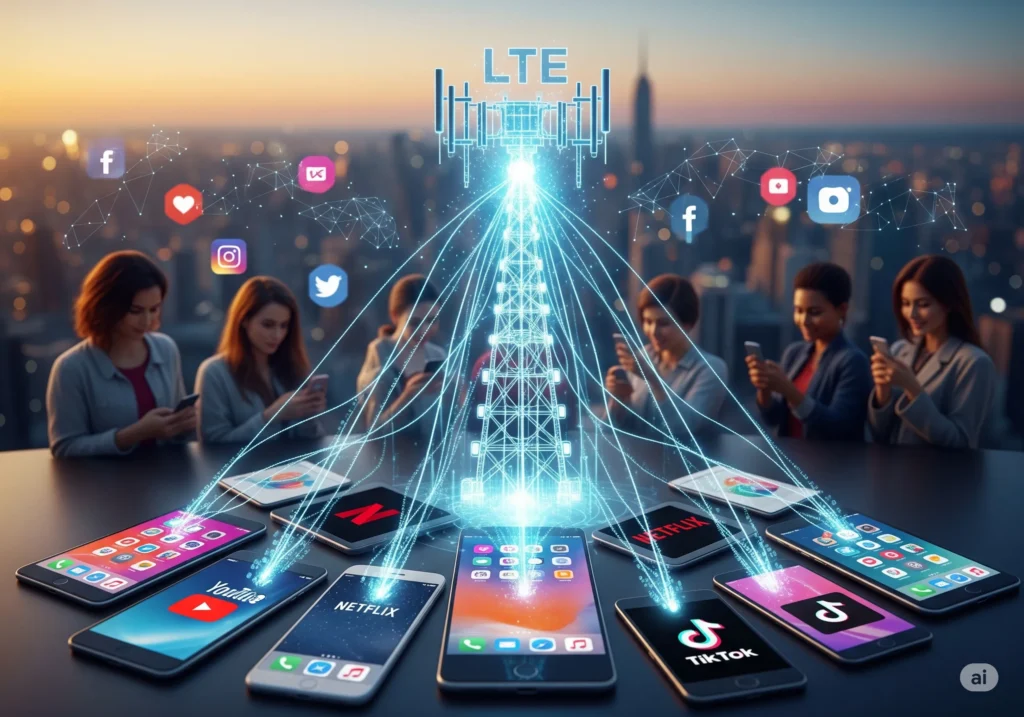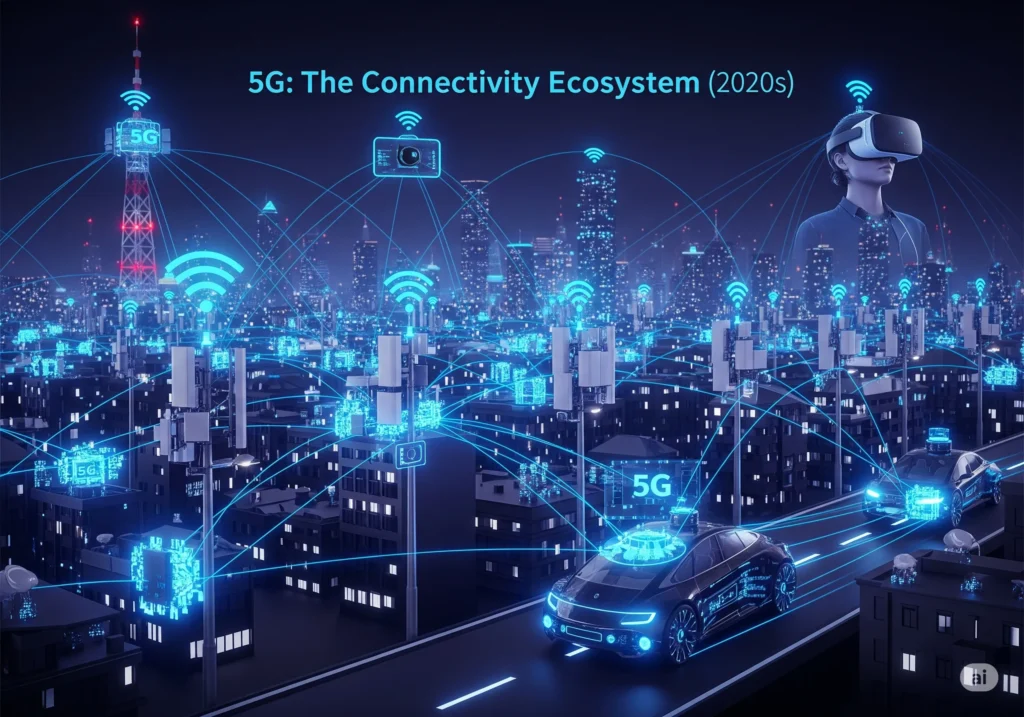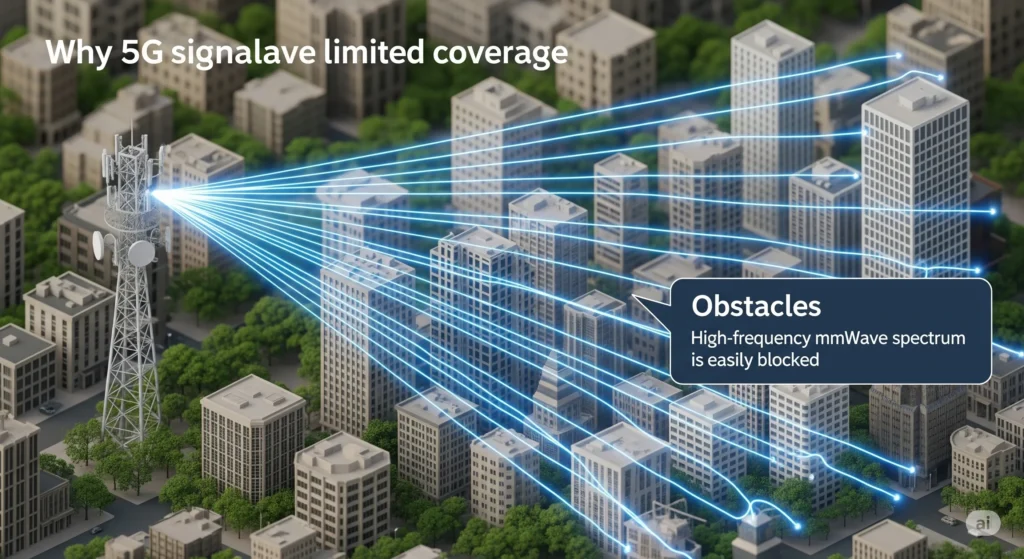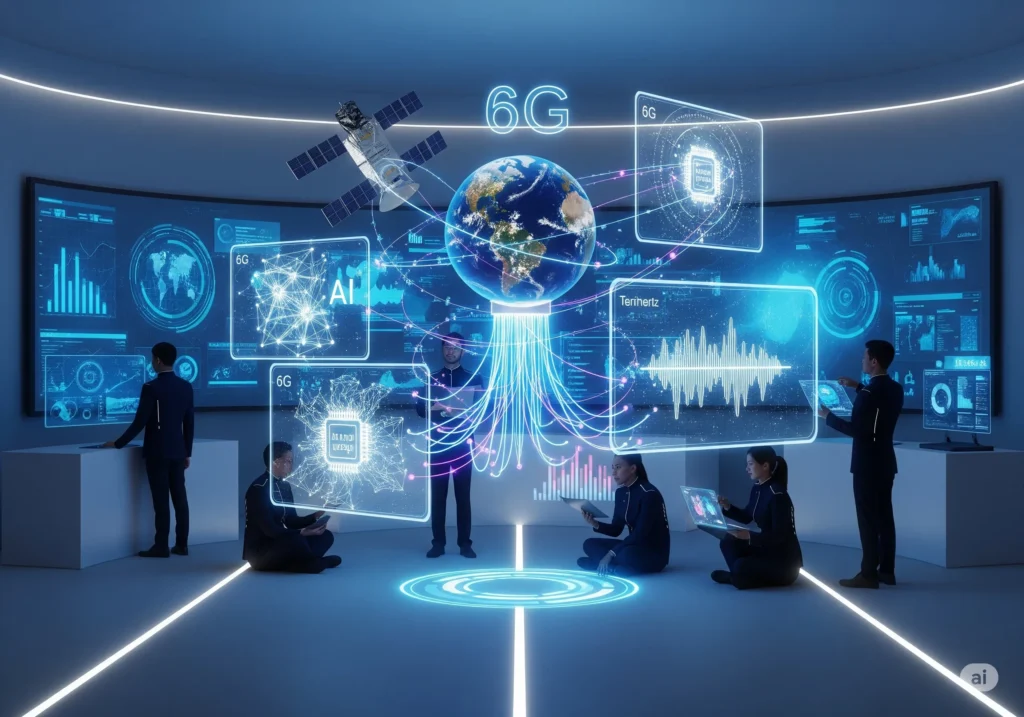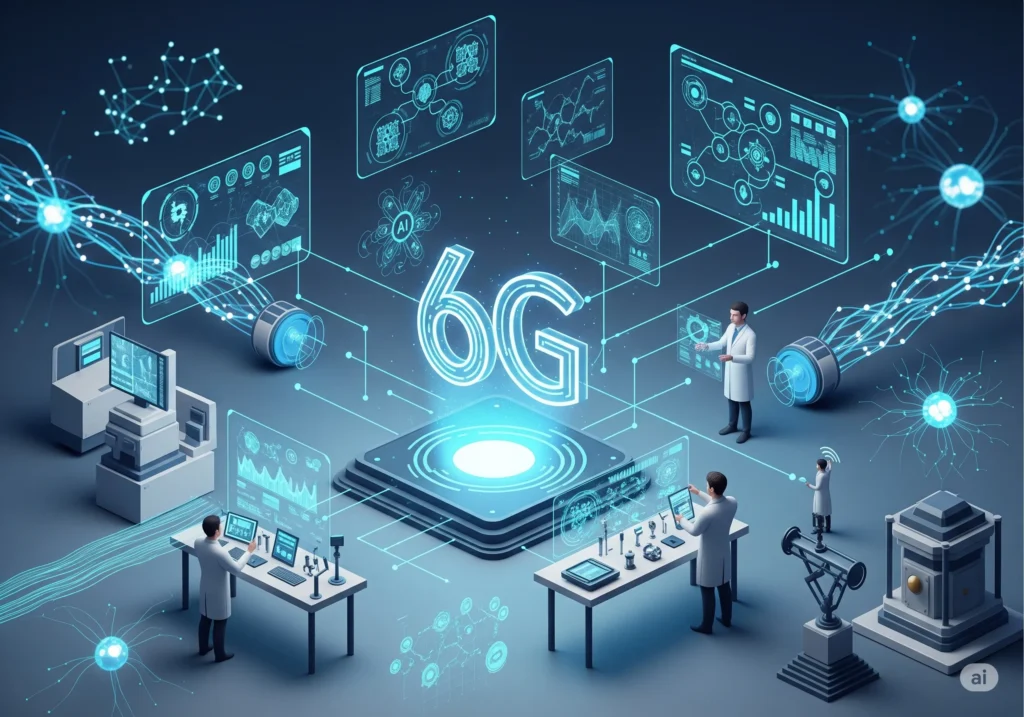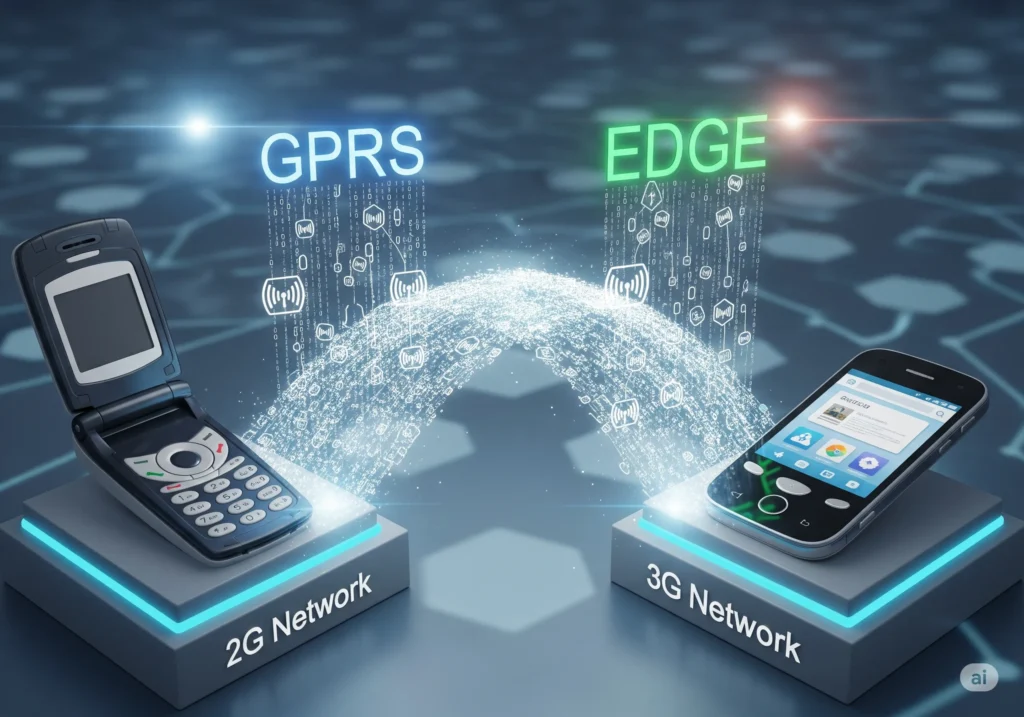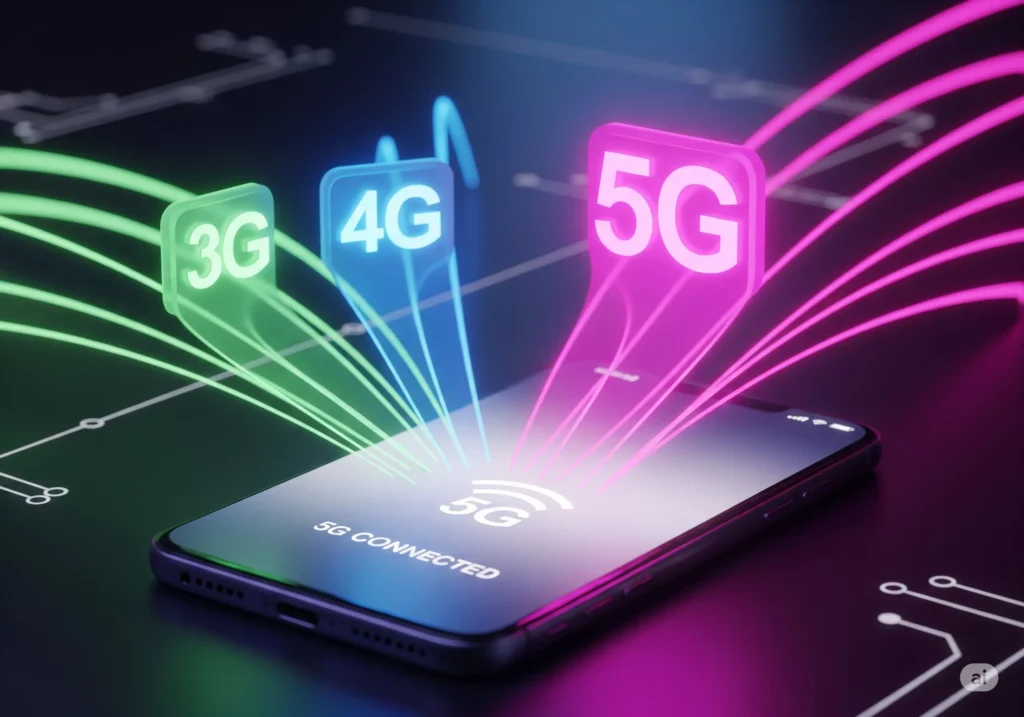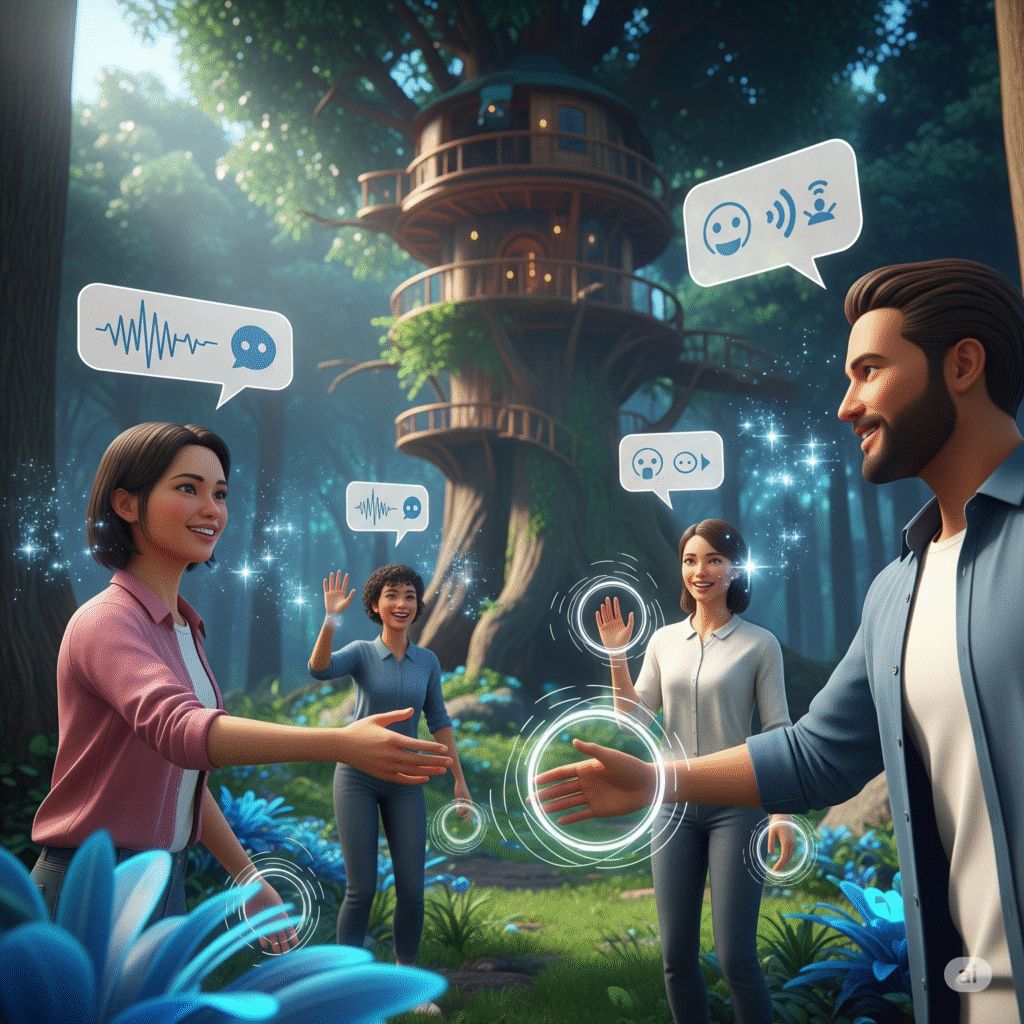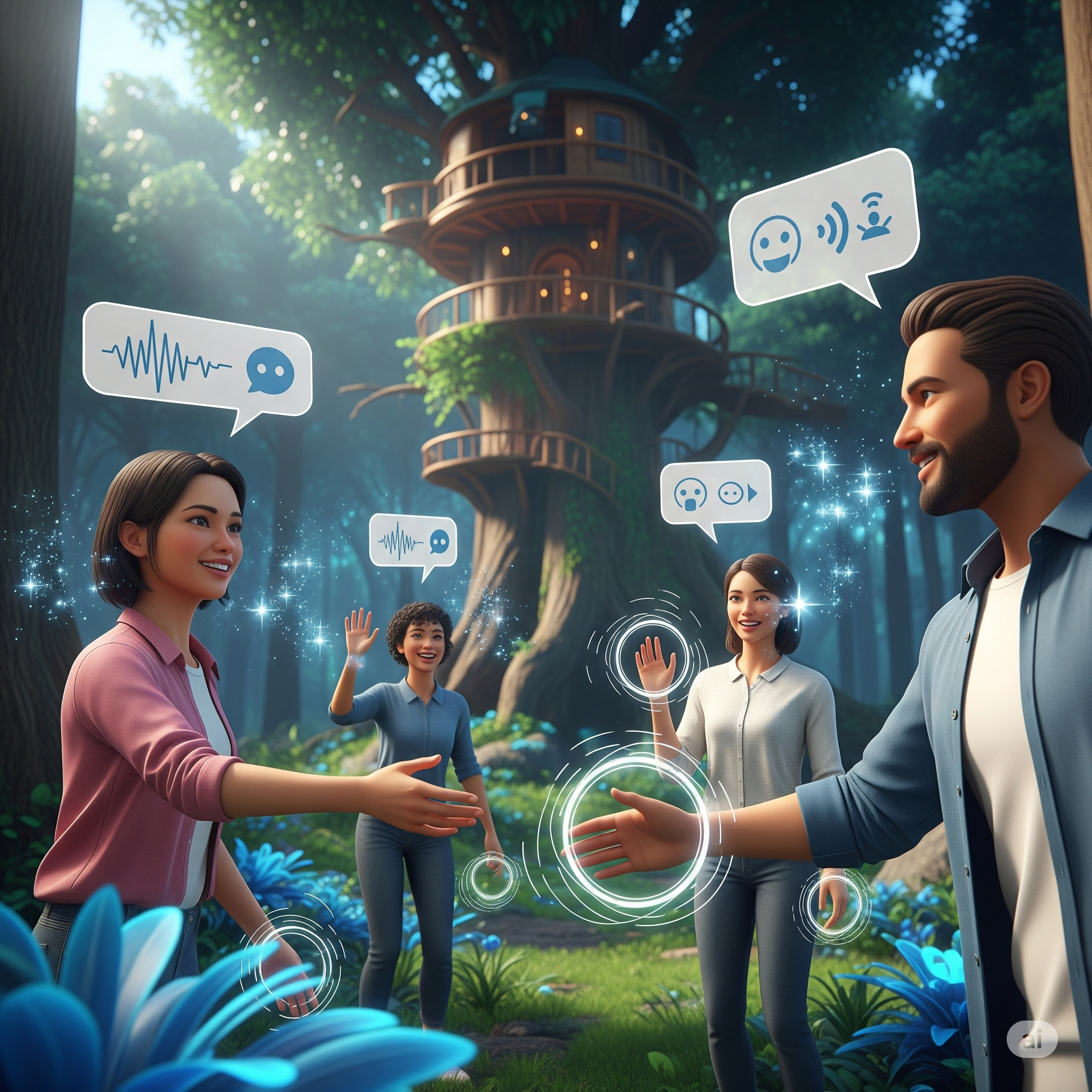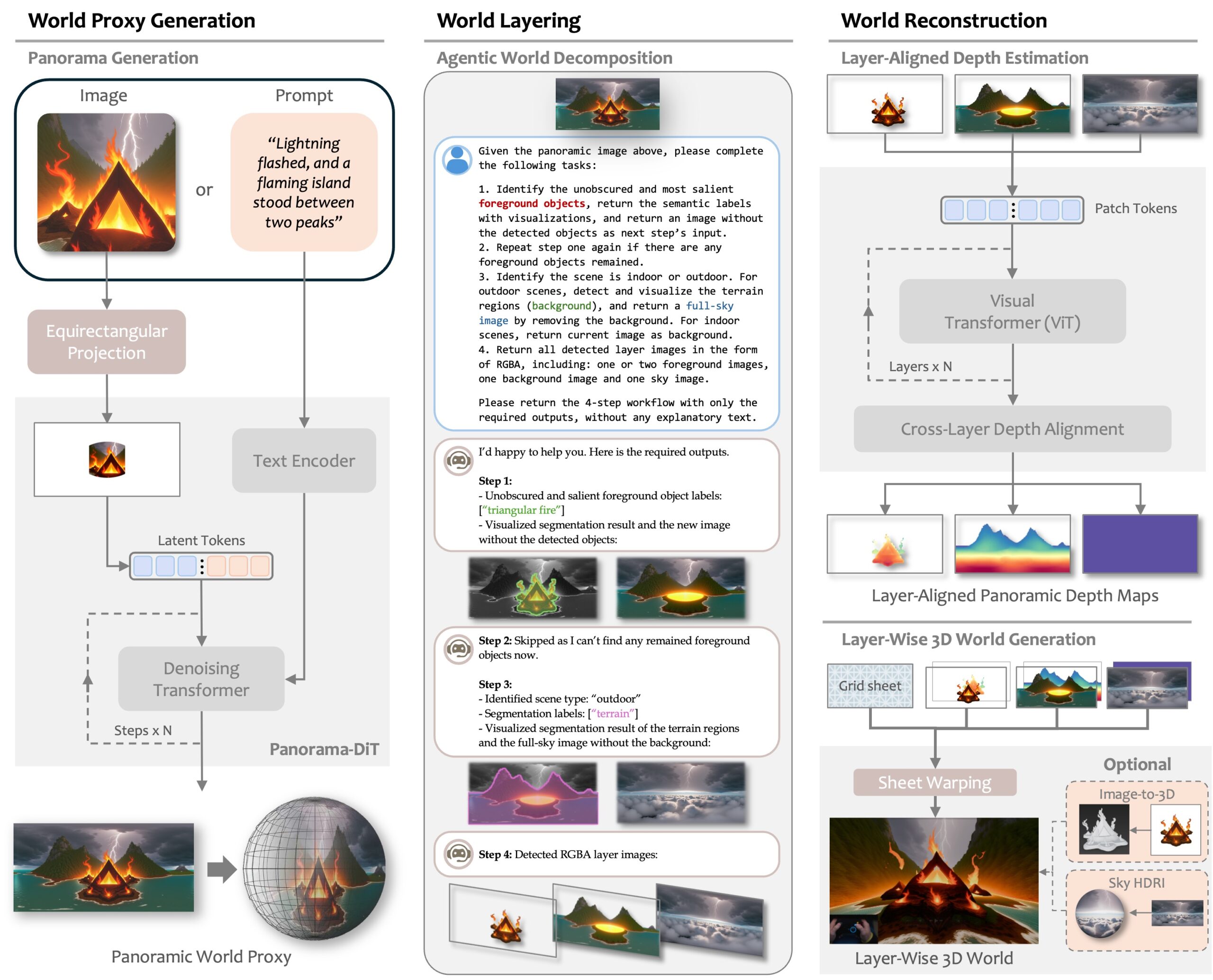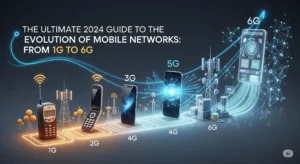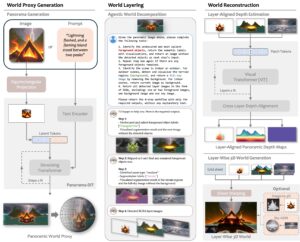The Evolution of Mobile Networks
The Evolution of Mobile Networks from 1G to 6G
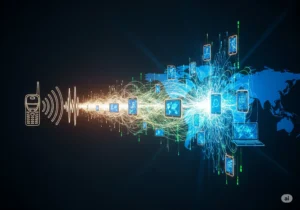
Introduction
In just a few decades, mobile networks have fundamentally reshaped the landscape of human connectivity. What began as a novelty for the privileged elite—a brick-like phone for making analog calls—has blossomed into a global nervous system of interconnected devices, powering everything from global stock markets to the simple act of ordering a ride. The journey from 1G to today’s cutting-edge 5G and the visionary promise of 6G is more than a story of increasing speed; it’s a chronicle of technological breakthroughs that have continuously redefined what is possible.
Thank you for reading this post, don't forget to subscribe!This in-depth guide is for anyone who has ever wondered what happens behind the screen of their smartphone. We will embark on a detailed exploration of each “G” (Generation), dissecting the core technologies, understanding the economic drivers, and analyzing the profound societal shifts they have enabled. We will move beyond the headlines to provide a comprehensive look at how each generation built upon its predecessor, creating a digital world that is faster, smarter, and more interconnected with every passing year.
Understanding the Fundamentals: What Defines a “Generation”?
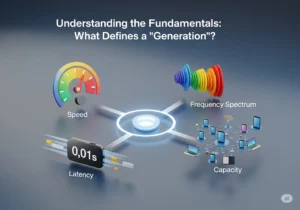
Before we dive into the history, it’s crucial to understand the fundamental metrics that define and differentiate each generation of mobile networks. A new generation isn’t simply a marketing term; it’s a significant upgrade defined by international standards (primarily by the International Telecommunication Union, or ITU) and marked by a paradigm shift in technology.
Key Metrics and Concepts:
- Speed (Data Rate): Measured in bits per second (bps), this is the most common metric. It represents how much data can be transferred over the network in a given time. Early generations measured speeds in kilobits per second (kbps), while today’s networks operate in gigabits per second (Gbps).
- Latency: This is the time it takes for a data packet to travel from its source to its destination and back. It is a measure of responsiveness. Lower latency is critical for real-time applications like online gaming, autonomous driving, and remote surgery.
- Capacity: This refers to the total amount of data a network can handle. It is directly related to the number of users and devices that can be supported simultaneously without a drop in performance.
- Frequency Spectrum: Mobile networks use radio waves to transmit data. The frequency bands used (low, mid, or high band) determine the trade-off between coverage (how far the signal travels) and capacity (how much data it can carry).
With these concepts in mind, let’s trace the evolution of this incredible technology.
The Foundations: The Early Generations
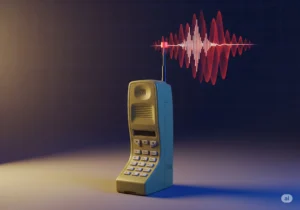
1G: The Analog Dawn (1980s)
The first generation of mobile telephony was a marvel of its time, though rudimentary by today’s standards.
- Technical Details: 1G networks were built on analog technology, primarily using standards like NMT (Nordic Mobile Telephone) and AMPS (Advanced Mobile Phone System). Unlike digital networks, these systems transmitted voice as continuous analog waves. The phones were large, heavy, and expensive, often relegated to car installations.
- Speed & Functionality: With speeds of up to 2.4 kbps, 1G was strictly for voice calls. There was no concept of data transfer, texting, or even a secure connection. The lack of encryption meant calls could be easily intercepted.
- Economic & Social Impact: 1G was a luxury item, primarily used by executives and the wealthy. It was a status symbol that signaled mobility and importance. Its limited coverage and high costs prevented mass adoption, but it successfully proved the viability of wireless communication and set the stage for the next wave of innovation.
2G: The Digital Leap (1990s)
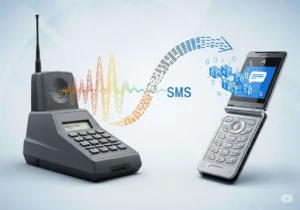
The transition from 1G to 2G represented a fundamental paradigm shift from analog to digital, and with it came a wave of new possibilities.
- Technical Details: The most dominant 2G standard was GSM (Global System for Mobile Communications), a digital technology that converted voice into digital data packets. Another competing standard was CDMA (Code Division Multiple Access). This digital conversion dramatically improved call clarity, reduced noise, and, for the first time, introduced encryption for secure communication.
- Key Innovations: 2G’s most significant innovation was the birth of data services. The technology supported SMS (Short Message Service), which, despite its humble 160-character limit, would become a global cultural phenomenon. Later enhancements like GPRS (General Packet Radio Service) and EDGE (Enhanced Data Rates for GSM Evolution) introduced “2.5G” and “2.75G,” providing low-speed data connections for early web Browse and WAP services.
- Economic & Social Impact: 2G led to the mass-market adoption of mobile phones. Devices became smaller, battery life improved, and the cost of service dropped significantly. Texting became a primary mode of communication, giving rise to new social norms and a new language of shorthand. The ability to send data, even at low speeds, laid the groundwork for the modern mobile internet.
3G: The Mobile Internet Revolution (Early 2000s)
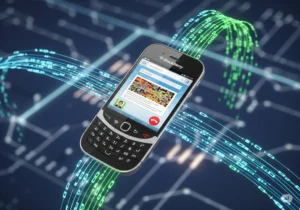
3G was the generation that truly brought the internet to the palm of our hands, transforming phones from communication devices into genuine multi-purpose tools.
- Technical Details: 3G was built on technologies like UMTS (Universal Mobile Telecommunications System) and HSPA (High-Speed Packet Access), which were a significant step up from 2G’s data capabilities. It moved from circuit-switched to packet-switched data, allowing for “always-on” mobile broadband.
- Key Innovations: With speeds ranging from a few hundred kbps to several Mbps, 3G made real mobile web Browse, video calling, and email possible on the go. This generation coincided with the rise of the first true smartphones, like the BlackBerry and early iPhones, which relied on 3G to deliver a new class of applications.
- Economic & Social Impact: 3G was the foundation of the modern smartphone era. It enabled a new ecosystem of mobile applications (the app store model), changing everything from how we consume media to how we work. It also led to an explosion in data usage, forcing network providers to adapt their business models.
The Current Era: 4G and 5G
4G: The High-Speed Broadband Era (Late 2000s – 2010s)
While 3G gave us mobile internet, 4G supercharged it, making seamless, high-definition experiences a daily reality.
- Technical Details: The primary technology behind 4G is LTE (Long-Term Evolution). It represents a shift to an all-IP (Internet Protocol) network architecture, meaning all services, including voice, are carried over a single data network. This streamlined architecture drastically improved efficiency and speed. Innovations like VoLTE (Voice over LTE) for HD voice calls and Massive MIMO (Multiple-Input, Multiple-Output) antennas to improve network capacity became standard.
- Speed & Latency: 4G delivered speeds of 100 Mbps to 1 Gbps, with latency around 50 milliseconds. This was a game-changer for data-intensive activities.
- Societal Impact: 4G fueled the “app economy” we know today. Social media platforms like Instagram and TikTok, ride-sharing apps like Uber, and streaming services like YouTube and ChatGPT and Netflix became ubiquitous because 4G could handle the data demands of high-quality video and real-time interaction. It was the backbone of the smartphone boom.
5G: The Connectivity Ecosystem (2020s)
5G is not just a faster version of 4G; it’s a completely new paradigm designed to connect everything, not just phones. It’s the infrastructure for a future defined by smart devices and real-time data.
- Technical Breakdown:
- Spectrum Utilization: 5G uses a multi-band approach:
- Sub-6 GHz: The main workhorse for wide-area coverage, offering speeds that are a significant improvement over 4G.
- mmWave (millimeter wave): Extremely high frequencies that offer multi-gigabit speeds but have a short range and are easily blocked by obstacles. Ideal for dense urban areas and specific venues.
- Network Slicing: A key innovation that allows operators to create virtual, customized networks on a single physical infrastructure. For example, an autonomous car network could be given a slice with ultra-low latency, while a smart meter network could get a slice optimized for low power consumption.
- Beamforming: A technology that directs radio signals in a focused beam directly to the user’s device, rather than broadcasting it in all directions. This improves efficiency and reduces interference.
- Spectrum Utilization: 5G uses a multi-band approach:
- Key Differentiators from 4G:
- Latency: The most significant improvement. 5G latency is as low as 1 millisecond, compared to 4G’s 50 ms. This near-instantaneous response time is critical for applications where delay is not an option.
- Capacity: 5G can support up to 1 million devices per square kilometer, a massive increase over 4G’s thousands of devices. This is essential for the IoT (Internet of Things).
- Applications: The use cases for 5G go far beyond smartphones. They include:
- Smart Cities: Real-time traffic management, smart grids.
- Autonomous Vehicles: Instant communication between cars and infrastructure.
- Remote Healthcare: Performing surgeries remotely via robotic arms.
- AR/VR: Truly immersive virtual and augmented reality experiences with zero lag.
5G is the invisible web that will power the next industrial revolution, connecting not just people but every machine, sensor, and device on the planet.
The Next Frontier: The Vision of 6G
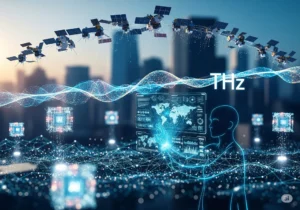
While 5G is still being deployed globally, researchers and tech companies are already working on the sixth generation of mobile technology. 6G is not just a plan; it’s a vision for a completely new hyper-connected world.
- The Need for 6G: 6G is necessary to address the limitations of 5G and to power a new wave of technologies that are not yet fully realized. These include holographic communication, the full integration of artificial intelligence into the network itself, and ubiquitous connectivity for a planet of trillions of smart devices.
- Predicted Core Technologies:
- Terahertz (THz) Frequencies: 6G will move into the Terahertz spectrum, which promises exponentially higher data rates. This high frequency will require new materials and transmission methods.
- AI Integration: Unlike 5G, where AI is an application on the network, 6G is envisioned as an “AI-native network.” This means the network will use AI and machine learning to manage itself, predict traffic patterns, and optimize performance autonomously.
- Space-to-Earth Communication: 6G will likely integrate low-orbit satellites and aerial platforms (drones) to provide seamless, global coverage, eliminating connectivity dead zones.
- Visionary Applications:
- Holographic Communications: Imagine calling someone and seeing a lifelike, three-dimensional hologram of them in your room, communicating in real-time.
- Cyber-Physical Systems: 6G will blur the lines between the digital and physical worlds, enabling truly autonomous robots and systems that can interact with their environment in real time.
- Massive-Scale Automation: Everything from manufacturing plants to entire cities will be managed and optimized by interconnected, intelligent networks.
While 6G is still years away (with a potential commercial launch around 2030), the research being done today is paving the way for a future that sounds straight out of a science fiction movie.
Conclusion
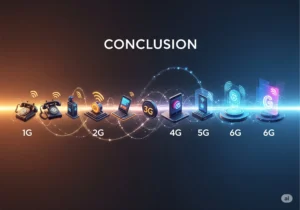
The journey from 1G to 6G is a remarkable testament to human ingenuity. Each generation has been a stepping stone, solving the problems of the past while unlocking new frontiers for the future. 1G gave us mobility, 2G gave us a voice, 3G gave us the internet, 4G gave us high-speed connectivity, and 5G is connecting everything in a smart, responsive network.
The evolution of mobile networks is more than a story of increasing speed and power; it’s a narrative of societal transformation. It has democratized information, created new economies, and fundamentally changed how we live, work, and interact with the world around us. As we look towards 6G, we can be certain that the next chapter will be even more revolutionary, bringing us closer to a future where connectivity is not just fast—it’s ubiquitous, intelligent, and an integral part of our very reality.
Frequently Asked Questions (FAQ)
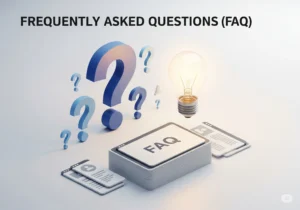
1. What is the main difference between 4G and 5G?
infographic comparing 4G and 5G by showing their respective speeds, latencies, and device capacities.
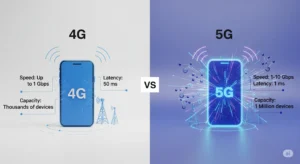
The main difference lies in three areas: speed, latency, and capacity. While 4G offers good speeds for streaming and Browse, 5G is up to 10 times faster, with near-zero latency (1ms). This low latency and massive capacity allow 5G to
support a huge number of connected devices (IoT), making it ideal for self-driving cars, smart cities, and real-time applications that 4G cannot handle.
2. Why can’t I get a 5G signal everywhere?
5G deployment is still ongoing. The signal is strongest in urban and densely populated areas because 5G technology, especially the fastest mmWave (millimeter wave) spectrum, has a shorter range and is easily blocked by physical objects like buildings and trees. Network providers are still building the infrastructure to provide wider coverage.
3. What does 6G promise that 5G cannot deliver?
6G is expected to be a massive leap forward, offering speeds up to 100 times faster than 5G and near-instantaneous latency. Its core promise is the full integration of artificial intelligence into the network, enabling futuristic applications like holographic communication, space-to-earth connectivity, and a truly unified smart world where every device is intelligently connected.
4. Is 6G a real thing, or is it just a concept?
6G is currently a real and active area of research and development. While the technology is not yet finalized, major tech companies, universities, and governments worldwide are investing heavily in research. The standards for 6G are expected to be defined by the late 2020s, with commercial rollout potentially beginning around 2030.
5. What do GPRS and EDGE mean?
GPRS (General Packet Radio Service) and EDGE (Enhanced Data Rates for GSM Evolution) were enhancements to 2G networks. They are often referred to as “2.5G” and “2.75G” because they provided the first taste of packet-switched data and mobile internet access, though at very low speeds. They were the bridge between the simple voice-only 2G and the full mobile internet of 3G.
6. How does my phone choose which network (4G, 5G) to use?
Your smartphone automatically connects to the highest-generation network available and supported by your device and carrier. If a 5G signal is strong, it will use that. If you move into an area with no 5G coverage, it will seamlessly fall back to a 4G or even a 3G network to maintain your connectivity.
7. Is 5G safe?
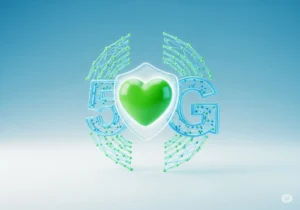
Yes. Extensive research by health organizations like the World Health Organization (WHO) and the International Commission on Non-Ionizing Radiation Protection (ICNIRP) has consistently shown that the radio frequencies used by 5G and other mobile technologies are well within safety guidelines and do not pose a health risk. These frequencies are non-ionizing, meaning they do not have enough energy to damage DNA.
What is ChatGPT? The AI That’s Changing Our World

